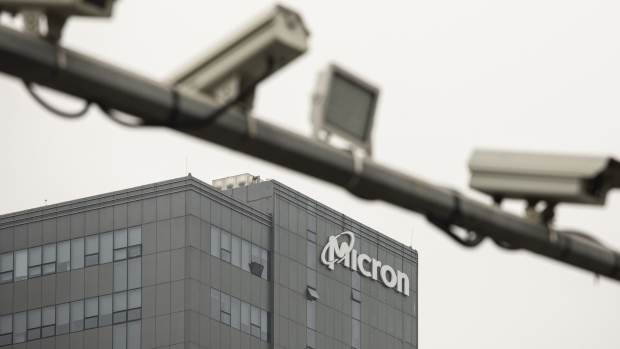May 17, 2023
Micron Is Said to Get $1.5 Billion From Japan for Next-Gen Chips
, Bloomberg News

(Bloomberg) -- Micron Technology Inc. is poised to land about ¥200 billion ($1.5 billion) in financial incentives from the Japanese government to help it make next-generation memory chips in the country, according to people familiar with the matter, the latest step in Tokyo’s effort to bolster domestic semiconductor production.
The US company will use the money as part of its plan to install advanced, EUV chipmaking equipment from ASML Holding NV at its facility in Hiroshima to fabricate DRAM chips, said the people, asking not to be identified because the agreement isn’t public. Micron on Thursday confirmed it would invest as much as ¥500 billion in Japan, as Prime Minister Fumio Kishida met with a delegation of chip executives, including Micron Chief Executive Officer Sanjay Mehrotra.
Micron shares rose 2.4% in premarket trading before New York exchanges opened on Thursday. The stock had previously closed at $64.92.
Tokyo Electron Ltd. spearheaded a rally in chipmaking gear suppliers, particularly those that provide gear or technology that support EUV. It rose 5.5% in Tokyo trading, while peers such as Lasertec Corp. and Hoya Corp. rose more than 3%.
The financing is the latest sign of Japan’s ambitions in developing its own semiconductor industry, a potential backup to Taiwan amid intensifying tensions between the US and China. The government is already spending billions of dollars to encourage Taiwan Semiconductor Manufacturing Co. to add production capacity in the country, and to finance a domestic chip venture, Rapidus Corp., with aspirations to make 2-nanometer chips by 2027. The Micron deal will bring EUV equipment to Japan for the first time, a step toward cutting-edge manufacturing the government has sought.
Read more: One Man Tries the Impossible in Restoring Japan’s Chip Industry
The agreement is also a retort to Beijing, which launched a cybersecurity review of the Boise, Idaho-based company after the Biden administration leveled sweeping restrictions on chip-related exports to China. That threatens the last American memory chipmaker’s ability to sell into China, where it now gets about 11% of its revenue. Kishida will receive leaders from the Group of Seven countries, including US President Joe Biden, in Hiroshima between May 19 and May 21.
“Micron’s Hiroshima factory will play a key role in the G-7’s ambition to strengthen semiconductor chip supply chains,” said Akira Minamikawa, an analyst with the research firm Omdia. “It is the most important location for the US company.”
Micron’s Hiroshima factory, a former production site for the now-defunct Elpida Memory Inc., houses some of the US firm’s best engineers, Minamikawa said. Japan’s Ministry of Economy, Trade and Industry said last year it would provide as much as ¥46.5 billion to Micron for production at the facility.
The US company has invested more than $13 billion in Japan since 2013, including for a push last year to produce what it calls one-beta DRAM chips. The latest funding will help Micron produce with what it calls one-gamma production, a more advanced technology that Micron plans to launch in late 2024. Suppliers that will benefit from Micron’s investments include Tokyo Electron, as well as ASML of the Netherlands.
In announcing its Japan investment, Micron didn’t specify how much support it would receive from the government. The city of Hiroshima is also expected to support the project.
The last remaining US maker of computer memory survived fierce industry consolidation through a string of acquisitions in prior downturns. While it’s added scale, something that helps with the brutal cost competition of manufacturing memory, it’s still much smaller than Samsung Electronics Co., the leader in the industry.
As the memory chip industry hit a supply glut this year, Micron reported a loss of more than $2 billion dollars in the latest quarter, as the selling price of memory fell below the cost of production. Micron’s management reacted with what they called a historically quick response, cutting pay, jobs and production and calling on its peers to follow suit. The company has said that the second half of 2023 should prove the bottom for the market for DRAM particularly if others also cut production.
The only other US company still involved in the memory chip industry at scale is Western Digital Corp., which doesn’t manufacture its own products, instead relying on partner Kioxia Corp.’s facilities in Japan to make flash memory. Micron has used its status as the lone US memory maker to push Washington to subsidize the return of domestic manufacturing in the US. Its executives have been leading voices in the lobbying of government.
Unlike rivals Samsung and SK Hynix Inc., Micron didn’t move any of its wafer fabrication work to mainland China. Outside of its home country, Micron has plants in Taiwan, Singapore and Japan, holdovers from past acquisitions.
While that makes Micron less vulnerable to any actions by Beijing, its close relationship with Washington’s efforts to bolster chip production domestically may have contributed to China’s regulatory scrutiny. Like other US chipmakers, Micron is still dependent on the global electronics supply chains that often run through Chinese factories.
(Updates with Micron’s announcement of ¥500 billion investment in Japan)
©2023 Bloomberg L.P.





